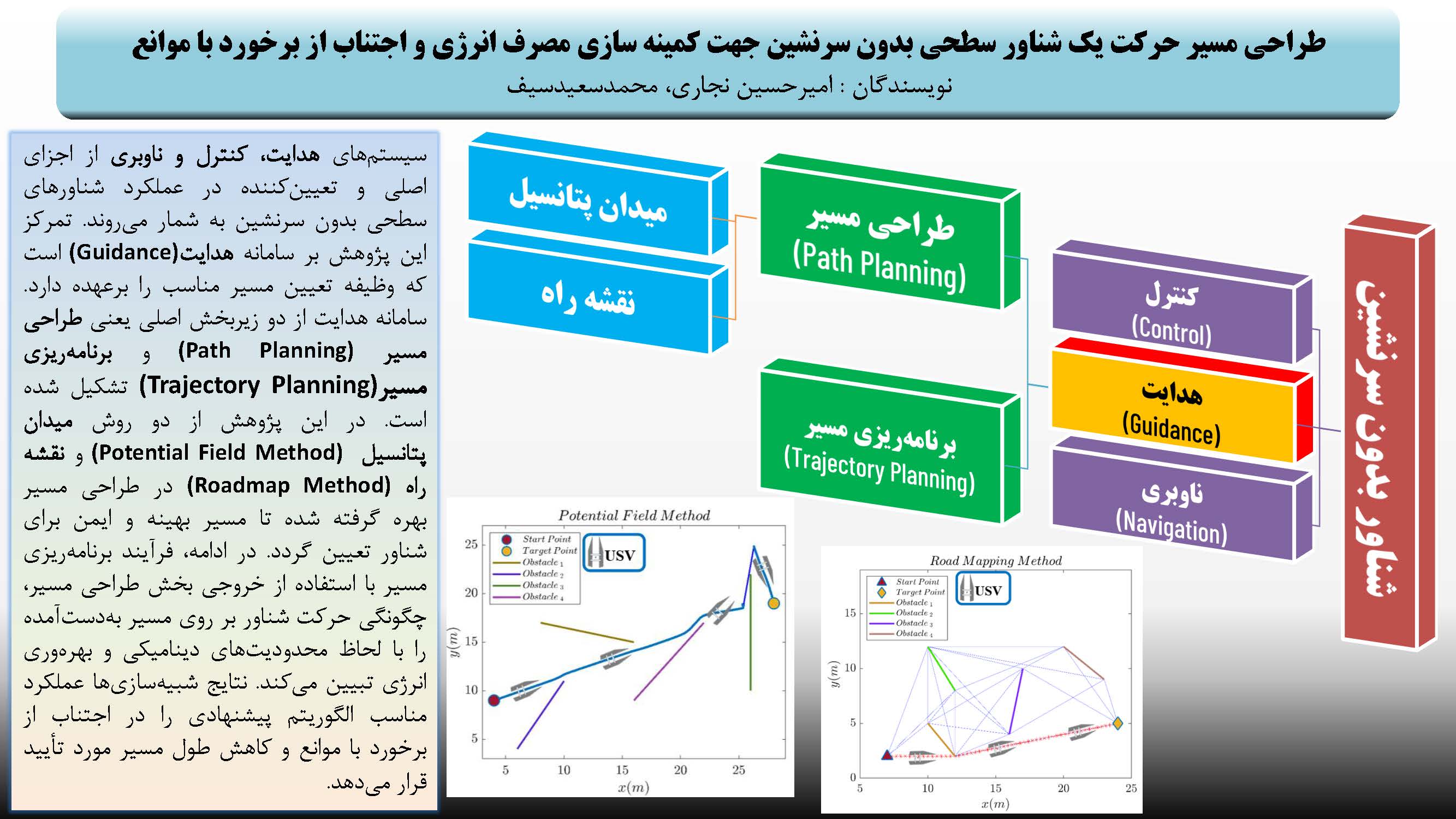1. Lv, C., Yu, H., Chi, J., Xu, T., Zang, H., lue Jiang, H., & Zhang, Z. (2019). A hybrid coordination controller for speed and heading control of underactuated unmanned surface vehicles system. Ocean Engineering, 176, 222-230. [
DOI:10.1016/j.oceaneng.2019.02.007]
2. Palomeras, N., Vallicrosa, G., Mallios, A., Bosch, J., Vidal, E., Hurtos, N., ... & Ridao, P. (2018). AUV homing and docking for remote operations. Ocean Engineering, 154, 106-120. [
DOI:10.1016/j.oceaneng.2018.01.114]
3. Xia, Y., Xu, K., Li, Y., Xu, G., & Xiang, X. (2019). Improved line-of-sight trajectory tracking control of under-actuated AUV subjects to ocean currents and input saturation. Ocean engineering, 174, 14-30. [
DOI:10.1016/j.oceaneng.2019.01.025]
4. Lee, T., Kim, H., Chung, H., Bang, Y., & Myung, H. (2015). Energy efficient path planning for a marine surface vehicle considering heading angle. Ocean Engineering, 107, 118-131. [
DOI:10.1016/j.oceaneng.2015.07.030]
5. Zeng, Z., Lian, L., Sammut, K., He, F., Tang, Y., & Lammas, A. (2015). A survey on path planning for persistent autonomy of autonomous underwater vehicles. Ocean Engineering, 110, 303-313. [
DOI:10.1016/j.oceaneng.2015.10.007]
6. Lolla, T., Ueckermann, M. P., Yiğit, K., Haley, P. J., & Lermusiaux, P. F. (2012, May). Path planning in time dependent flow fields using level set methods. In 2012 IEEE International Conference on Robotics and Automation (pp. 166-173). IEEE. [
DOI:10.1109/ICRA.2012.6225364]
7. Lolla, T., Haley Jr, P. J., & Lermusiaux, P. F. J. (2015). Path planning in multi-scale ocean flows: Coordination and dynamic obstacles. Ocean Modelling, 94, 46-66. [
DOI:10.1016/j.ocemod.2015.07.013]
8. Kularatne, D., Bhattacharya, S., & Hsieh, M. A. (2016, June). Time and Energy Optimal Path Planning in General Flows. In Robotics: science and systems (pp. 1-10). [
DOI:10.15607/RSS.2016.XII.047]
9. Singh, Y., Sharma, S., Sutton, R., Hatton, D., & Khan, A. (2018). A constrained A* approach towards optimal path planning for an unmanned surface vehicle in a maritime environment containing dynamic obstacles and ocean currents. Ocean Engineering, 169, 187-201. [
DOI:10.1016/j.oceaneng.2018.09.016]
10. Bryson, A. E. (2018). Applied optimal control: optimization, estimation and control. Routledge. [
DOI:10.1201/9781315137667]
11. Yilmaz, N. K., Evangelinos, C., Lermusiaux, P. F., & Patrikalakis, N. M. (2008). Path planning of autonomous underwater vehicles for adaptive sampling using mixed integer linear programming. IEEE Journal of Oceanic Engineering, 33(4), 522-537. [
DOI:10.1109/JOE.2008.2002105]
12. Eichhorn, M. (2015). Optimal routing strategies for autonomous underwater vehicles in time-varying environment. Robotics and Autonomous Systems, 67, 33-43. [
DOI:10.1016/j.robot.2013.08.010]
13. Carroll, K. P., McClaran, S. R., Nelson, E. L., Barnett, D. M., Friesen, D. K., & William, G. N. (1992, June). AUV path planning: an A* approach to path planning with consideration of variable vehicle speeds and multiple, overlapping, time-dependent exclusion zones. In Proceedings of the 1992 symposium on autonomous underwater vehicle technology (pp. 79-84). IEEE. [
DOI:10.1109/AUV.1992.225191]
14. Garau, B., Bonet, M., Alvarez, A., Ruiz, S., & Pascual, A. (2009). Path planning for autonomous underwater vehicles in realistic oceanic current fields: Application to gliders in the western mediterranean sea. Journal of Maritime Research, 6(2), 5-22.
15. Garau, B., Alvarez, A., & Oliver, G. (2005, April). Path planning of autonomous underwater vehicles in current fields with complex spatial variability: an A* approach. In Proceedings of the 2005 IEEE international conference on robotics and automation (pp. 194-198). IEEE. [
DOI:10.1109/ROBOT.2005.1570118]
16. Le, A. V., Prabakaran, V., Sivanantham, V., & Mohan, R. E. (2018). Modified a-star algorithm for efficient coverage path planning in tetris inspired self-reconfigurable robot with integrated laser sensor. Sensors, 18(8), 2585. [
DOI:10.3390/s18082585] [
PMID] [
]
17. Song, R., Liu, Y., & Bucknall, R. (2019). Smoothed A* algorithm for practical unmanned surface vehicle path planning. Applied Ocean Research, 83, 9-20. [
DOI:10.1016/j.apor.2018.12.001]
18. Zadeh, S. M., Powers, D. M., Yazdani, A., Sammut, K., & Atyabi, A. (2016). Differential evolution for efficient AUV path planning in time variant uncertain underwater environment. arXiv preprint arXiv:1604.02523. [
DOI:10.48550/arXiv.1604.02523]
19. Niu, H., Ji, Z., Savvaris, A., & Tsourdos, A. (2020). Energy efficient path planning for unmanned surface vehicle in spatially-temporally variant environment. Ocean Engineering, 196, 106766. [
DOI:10.1016/j.oceaneng.2019.106766]
20. Lutz, Max, and Thomas Meurer. "Optimal trajectory planning and model predictive control of underactuated marine surface vessels using a flatness-based approach." 2021 American Control Conference (ACC). IEEE, 2021. [
DOI:10.23919/ACC50511.2021.9483265]
21. Sayyadi, H., Babakhani, A. (2009). Path planning & trajectory tracking of AUVs in dynamic environments using intelligent converted solution and classical methods. Marine Engineering, 5(9), 19-34. https://dor.isc.ac/dor/20.1001.1.17357608.1388.5.9.2.0
22. Wang, Z., Li, G., & Ren, J. (2021). Dynamic path planning for unmanned surface vehicle in complex offshore areas based on hybrid algorithm. Computer Communications, 166, 49-56. [
DOI:10.1016/j.comcom.2020.11.012]
23. Stutters, L., Liu, H., Tiltman, C., & Brown, D. J. (2008). Navigation technologies for autonomous underwater vehicles. IEEE Transactions on Systems, Man, and Cybernetics, Part C (Applications and Reviews), 38(4), 581-589. [
DOI:10.1109/TSMCC.2008.919147]
24. Zhao, L., Bai, Y., & Paik, J. K. (2023). Achieving optimal-dynamic path planning for unmanned surface vehicles: A rational multi-objective approach and a sensory-vector re-planner. Ocean Engineering, 286, 115433. [
DOI:10.1016/j.oceaneng.2023.115433]
25. Najari A, Seif M S. (2025). Dynamic modeling of surface vessel maneuvering based on deep learning using recurrent neural networks. marineeng; 21 (46) :80-88 http://dx.doi.org/10.61882/marineeng.21.46.7 [
DOI:10.61882/marineeng.21.46.7]
26. Taheri, E., Ferdowsi, M. H., & Danesh, M. (2019). Path planning on line for an autonomous underwater robot in an almost unknown environment using local Rapidly-exploring Random Tree (RRT) method. Darya Fanon (Marine Science Journal), 6(3), 1-14. SID. (In Persian). https://civilica.com/doc/1017855
27. Zhou, X., Wu, P., Zhang, H., Guo, W., & Liu, Y. (2019). Learn to navigate: cooperative path planning for unmanned surface vehicles using deep reinforcement learning. Ieee Access, 7, 165262-165278. [
DOI:10.1109/ACCESS.2019.2953326]









































